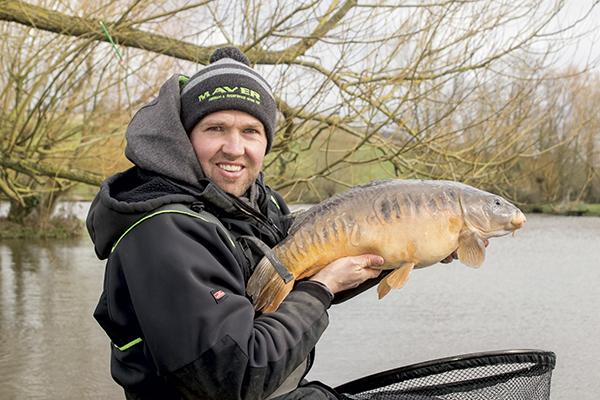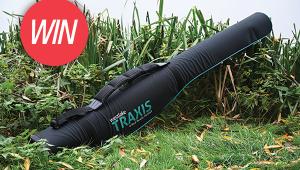Go With The Grain!

Fishery rules. We all have to abide by them, and sometimes that means that we have to adapt if they include certain bans on baits and tactics. For example, the Garbolino Winter Festival held at White Acres in Cornwall at the back end of each year is float only, and natural baits only, which means the tip rods and pellets stay at home.
It’s a similar scenario at Viaduct Fishery in Somerset, where between November and March there is a ban on the use of pellets and you cannot use any type/style of Method feeder, so to target the carp and skimmers beyond the pole line it’s either bomb/feeder or waggler.
It’s a fair bet to assume that the majority of anglers would go for the tip option, but they could be missing a trick, and to explain more about how fishing the waggler can give you an advantage we joined Maver’s Callum Dicks for a session on a windswept Campbell Lake.
“Don’t get the wrong idea that you cannot catch well on the tip,” Callum commented, as he started to set up on the lake’s Peg 131. “You will, but the waggler gives a different bait presentation, especially when the water isn’t coloured, and a much better bite indication when you are targeting skimmers as well as carp.
“Often the carp feed later in a match, so the chance of putting 20lb of skimmers in the net early on can make a big difference to your final weight.”
Two of the more popular hook baits for the waggler at the venue are corn and bread, but the conditions that greeted Callum – winds gusting to 40mph – meant that he would concentrate on fishing corn. “This wind has been blowing all night, so I expect there to be a bit of tow on the water, which would make fishing the bread ‘dead still’ impossible. Corn is the better option today as I’m looking for skimmers on the deck, as well as carp.”
Callum’s setup for the session is all about strength, as the carp in Campbell are all in excess of 6lb-plus, so it was no surprise that he had 0.17mm reel line loaded on his reel. However, there was also a little bit of finesse as he would be fishing with a 13ft waggler rod, not one of the commercial-type tools that you would normally associate when targeting carp.
“If you look at the setup I’m fishing, you will see that it’s tailored so that I can see the delicate bites from the skimmers. If I struck with a meaty pellet-waggler rod, I would most likely pull the hook out, so the cushioning effect of the rod top stops that. Also, you get a much faster line pickup on the strike with a 13ft rod, and it’s so much easier to cast lighter floats.”
The setup Callum referred to consisted of a 5g Maver Finesse insert loaded waggler, which was trapped on the line with line stops for easy depth adjustment. Down the line, he had three No8 droppers spread out above the hook link. The hooklength, which was attached to a small swivel, was 12 inches of 0.16mm Maver MV-R hooklength mono with a size 16 Maver MV-R Power Carp hook. “A 5g float might seem a little heavy, but it enables me to punch the rig out to the line clip so that everything straightens out, which in turn allows me to quickly sink the line before the wind can affect it.
“On the subject of which float to use, and this is my preference, the one I’m using today has a hollow insert that allows the light to penetrate, which in turn makes it highly visible at distance when it’s dotted down in the water. It’s a loaded waggler, which makes it easy to cast even in this strong wind, but the loading is adjustable. There are a number of brass washers that you can remove if you want the bristle to sit higher in the water. It’s also very buoyant, so it allows you to fish a bait overdepth with the tow, without the float getting pulled under as it drags along the deck. The buoyancy also helps to establish tension between the float and hook bait, so that you will see the shyest of bites.”
With the plan to fish on the bottom, Callum had to ensure that his rig was set to fish dead depth, so it was essential that he plumbed up his waggler setup accurately. To do this he had a second, identical float that he had removed the brass washers from.
“By removing some of the weight the float sits up in the water, so that the loading doesn’t govern how it sits it the water. This allows me to adjust the depth using the plummet to get an accurate setting. Once I’m happy, I’ll mark the depth on my rod and switch back to a fully loaded float.
“With the added No8s the bristle will sit with around half a centimetre showing above the water, which is fine with the breeze on the water today. If it was flat calm, then I’d add another washer to the loading, so just a blip of bristle showed.”
To ensure that he had the depth spot on, Callum had clipped up to ensure he hit the same mark every time, and after a number of adjustments he had his depth and was ready to kick off the session. “Before I start I’m going to fire out around 15 grains to put something visual falling through the water. Hopefully, if there are any carp around they will see them and I might get an early bonus. Once it settles, the corn will get the skimmers’ attention. Well, that’s the theory.
“Because I’m looking for skimmers as well as carp, I’m hooking my bait directly on the hook. It if was carp only, then I would hair rig the hook bait. Another advantage with corn is it is heavy, so it will sink nicely and its weight helps to keep it down and less affected by the tow, unlike maggots.”
Soon after the first cast it became clear that there was a heavy right-to-left pull on the water, and so to try and ‘lock down’ the bait Callum reset his depth to fish six inches over. It was then a case of waiting for the bites to come. “It’s no different whether you fish a tip or a float, you always have to try and make something happen, especially during the early stages of a match, when bites might be at a premium. I’m recasting every three minutes or so and pinging a few grains over the top, just to keep something falling through the water. Once the fish turn up, I’ll back off the amount I feed.”
Thirty minutes in, and it had become clear that the gusting wind had added to the push on the water, with more of a drag closer to Callum than out in the middle of the lake, where his float sat. This resulted in a bow being created in his line, which in turn caused his rig to be pulled off line. “Ideally, when fishing a waggler you want a floating line, so that you get a crisp, instant line pick-up when you strike, but you need calm water for the best results. I’ve started to sink my line with a few turns and a quick strike with the rod tip under the water.
“It might sound a bit ‘nerdy’, but you want a reel line that sits nicely on the surface film when it’s not too rough, but one that you can sink just below the surface when the wind affects it. The Maver MV-R Power Reel mono is my choice, but I suggest that you try a few lines that suit you if you plan to fish the waggler on commercials.”
Once he had better control of his presentation, Callum started to see indications of fish. They were followed by a few missed bites – probably small fish – before he finally connected with his first skimmer. It had taken over an hour for the fish to move in, but Callum pointed out that you often have to expect to wait for the action to arrive during the cooler months, even into late spring.
Presentation continued to be an issue as the tow had grown stronger, so even with his line sunk Callum couldn’t prevent his bait from being pulled to the left. To counter the drift he increased the amount of line on the deck to 12 inches, so that the swivel touched the bottom.
“That’s one of the reasons to use a long hook link when fishing corn, and even with that amount of line on the bottom my rig is still under tension.
The bites, however, were still at a premium, and to try and encourage the skimmers Callum increased the frequency he added the loose fed grains. A couple of better skimmers were soon netted, and after the wind abated somewhat he had his first carp of the session. That fish was followed by a string of smaller skimmers, and then the bites stopped. “I’ve definitely got fish in the area, but the extra loose feed might be spreading them out. I’m going to cut back on the amount and try and keep it in a tighter area, which in this wind might be a challenge. At least it’s calmed down a bit.”
The bigger skimmers returned and helped to boost Callum’s weight over the mid part of the session, but then they disappeared again. That seemed to be the switch for the carp to join the party. The final part of the session saw four more carp and a tench landed, plus a few more skimmers to top up the silvers net. “It was never going to be easy with the conditions here today, but I hope I’ve demonstrated that the waggler isn’t just for pellet fishing in the summer,” Callum concluded. “Could I have caught more on the bomb? Maybe, but you will see more skimmer bites on the float, and keeping the hook bait and loose feed falling through the water is going to attract more attention than a static bait. You often have to land a bait right in front of a fish when fishing the tip.
“Bread is a great alternative to corn, but it needs to be fished static six inches off the bottom to work well, and that’s not been an option today due to the heavy tow and strong wind affecting the surface. Had it been a calm day, then I would have tried it. However, it’s unlikely I would have picked up the skimmers, and you can’t loose feed bread, so I would suggest that you start on the corn, and if or when the carp turn up, then make the switch.”
- Log in or register to post comments













